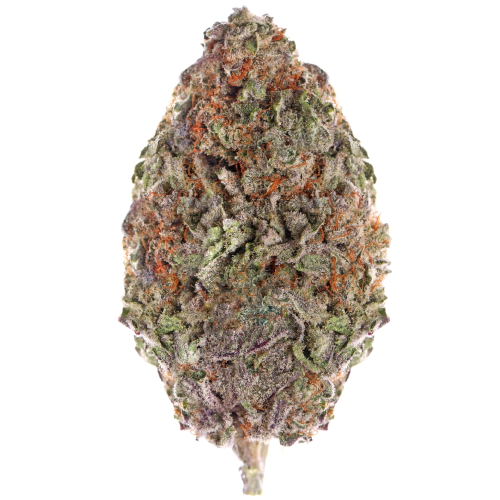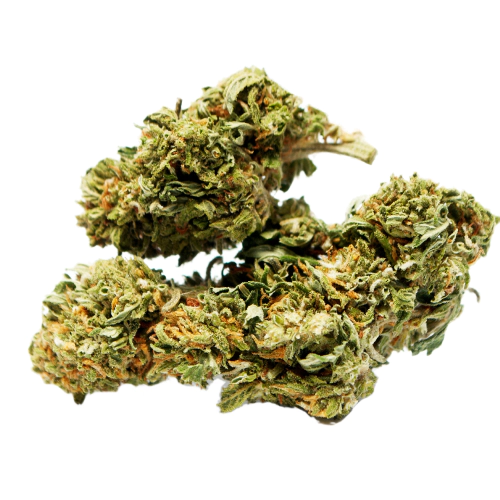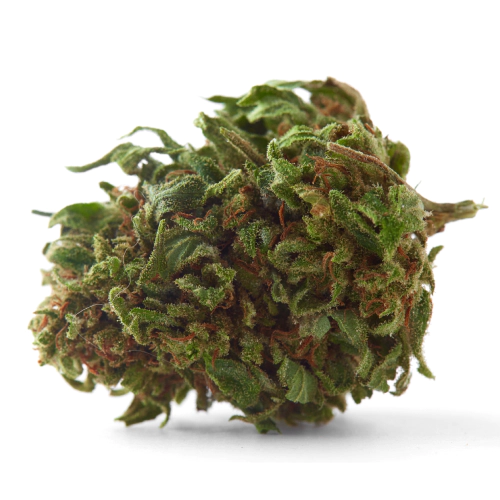THC 16.25 - 18.75%
CBD 0.04 - 0.21%
Effect Happy
Flavor Honey
17 - 19%
0.56 - 0.75%
0.08 - 0.12%
Tropical, Mango
Giggly
The Jolly Bean strain is a marijuana hybrid with Sativa-leaning genetics and a Sativa/Indica ratio of 60/40%. It is considered a moderately strong cannabis variety with a THC percentage of 17%-19%. Some cuts of Jolly Bean contain up to 0.56-0.75% CBD, which means it has multiple medical benefits for recreational and MMJ users.
The cannabinoid profile is as follows:
The aromas released by Jolly Bean buds are delicious. Smokers can smell tropical scents reminiscent of sweet mango and blueberry. They notice skunk and woody odors accented by herbal and spicy undertones on the exhale.
Myrcene is the prevailing terpene found in this weed, which induces a super lifting high. Other detected terpenes are caryophyllene, linalool, and limonene.
Affected by prevalent myrcene, the strain fills smokers’ minds with high-flying euphoria. The high is accompanied by an increase of sociability and creativity that can prompt tingles and giggles. As your mind flies higher, you’ll get a feeling of soothing calm and relaxation.
Most smokers admit that the Jolly Bean strain is potent enough to manage some irritating medical issues such as:
Potential side effects that this cannabis may cause are:
Amateur gardeners can buy Jolly Bean seeds with confidence because the growth difficulty of this phenotype is moderate. Cultivators who decide to grow it indoors can expect plants of 30-60 inches in height that yield at 1-2 oz./ft2. Outdoor growers will get plants of 60-80 inches in stature that yield at 10-15 oz./plant. The flowering cycle lasts 55-62 days, and the harvest is anticipated in 61 days. This weed produces oversized green nugs with thin orange hairs.
| THC | Tetrahydrocannabinol, or THC, is a major cannabis chemical compound. It is a psychoactive element that stimulates dopamine release and induces euphoria or happiness. THC-rich strains may be helpful with such conditions as lack of appetite, chronic pains , etc. It is considered to be the primary active marijuana component. | 17 - 19% |
| CBD | Cannabidiol, or CBD, is a major compound in cannabis, which is non-psychoactive. It is also proved to counteract the side effects of the second major component THC. CBD is widely used for medicinal purposes in rubs, oils and so on. It is helpful in muscle pain cases, may treat arthritis and migraines. Even Greeks used it against pain, while Queen Victoria applied it to get rid of menstrual cramps. | 0.56 - 0.75% |
| CBC | Cannabichromene, or CBC, is a minor cannabinoid, meaning that its quantity in cannabis is quite little. Though it has the same origin as CBD and THC, it is different in functions. Without any psychoactive effects, it is an efficient cannabis compound in combating acne and depression. CBC produces analgesic, antibacterial and anti-inflammatory effects. | 0.19 - 0.23% |
| CBG | Cannabigerol, or CBG, is one of the minor cannabis compounds in adult plants. On the other hand, young ones contain a lot of this antibacterial and anti-inflammatory component. During the growth, CBG is converted into different cannabinoids, mostly THC and CBD. The compound itself increases appetite and decreases eye pressure. | 0.08 - 0.12% |
| CBN | Cannabinol, or CBN, is a trace element in cannabis that is considered to be mildly psychoactive. It appears from oxidation THC, exposed to light and heat. CBN is mostly contained in old cannabis and in traditional hashish. It is effective against insomnia, bacterial infections and appetite loss. | 0 - 0.01% |
| THCV | Tetrahydrocannabivarin, or THC-V, is a compound contained in cannabis in trace amounts. Even though it is close to THC molecularly, it is different in effects. This compound may be psychoactive only in large amounts. THC-V reduces blood sugar, controls appetite, stimulates bone growth, etc. African Sativa strains are the richest in THC-V. | 0.05 - 0.06% |
| Pinene | Pinene is one of the most widespread terpenes in nature, found in pine trees, basil, nutmeg, parsley, and rosemary. Cannabis containing terpene (alpha-pinene or α-pinene) boasts a strong pine scent. Pinene is responsible for anti-inflammatory, pain-relieving, and anti-anxiety effects. | 0.03% |
| Myrcene | Myrcene (also known as β-myrcene) is one of the most common terpenes found in cannabis, representing more than 20% of the modern marijuana terpene profile. Myrcene has a distinct earthy, musky flavor, resembling cloves. It is responsible for calming and soothing effects of weed. Myrcene is also found in hops, thyme, mango, lemongrass, guava melon. | 0.53% |
| Ocimene | Ocimene (derived from the Ancient Greek word Ocimum meaning basil) is a terpene with sweet and herbaceous flavors, also boasting citrusy and woody undertones. Naturally, ocimene occurs in mint, parsley, orchids, hops, kumquats, mangoes, basil, bergamot, lavender, and pepper. Offers antifungal, anti-inflammatory, and antiviral properties. | 0.04% |
| Humulene | Humulene (also known as α-humulene) is one of the major terpenes found in cannabis, contributing to woody, earthy, spicy, herbaceous, and, mainly, floral aromas of cannabis. Used in modern medicine, humulene offers anti-inflammatory, antibacterial, and appetite suppressant effects, which have been well-researched by pharmaceutical companies. | 0.05% |
| Limonene | Limonene (also known as d-limonene) is the second most common terpene in nature and the third most common terpene in cannabis. It has a powerful citrus aroma and can be found in all citruses, including lemons, oranges, grapefruits, limes, juniper, etc. Limonene is known to elevate moods and provide anxiety, depression, and stress relief. | 0.08% |
| Linalool | Linalool (also known as beta linalool, linalyl alcohol, linaloyl oxide, and p-linalool) is one of the rarest terpenes found in cannabis, mostly in small quantities. Linalool is known for its spicy and lavender aroma, bringing relaxation and calming effects. It is also said to provide anti-inflammatory and analgesic properties that can be useful for athletes. | 0.09% |
| Caryophyllene | Caryophyllene (also known as beta or b caryophyllene) is a terpene found in many herbs and spices, such as black pepper, basil, rosemary, and oregano. Cannabis high in caryophyllene delivers a strong spicy, peppery aroma, resembling cinnamon and cloves. Caryophyllene offers potent anti-inflammatory and sedative effects. | 0.18% |
| Total terpenes content | 1.00% |
THC 16.25 - 18.75%
CBD 0.04 - 0.21%
Effect Happy
Flavor Honey
THC 19.33 - 20.33%
CBD 0.56 - 0.78%
Effect Tingly
Flavor Spicyherbal
THC 32 - 35%
CBD 0.54 - 0.67%
Effect Hungry
Flavor Lemon
THC 19.25 - 22.25%
CBD 0.06 - 0.43%
Effect Uplifted
Flavor Sweet
THC 28 - 29%
CBD 1 - 1.17%
Effect Tingly
Flavor Spicyherbal
THC 21 - 24%
CBD 2 - 2.3%
Effect Relaxed
Flavor Lemon
THC 13.5 - 16.5%
CBD 0.11 - 0.33%
Effect Uplifted
Flavor Chemical

THC 19.75 - 21.25%
CBD 0.37 - 0.7%
Effect Relaxed
Flavor Sweet
THC 9.5 - 12.25%
CBD 0.06 - 0.4%
Effect Euphoric
Flavor Berry
THC 17.43 - 17.67%
CBD 0.34 - 0.7%
Effect Tingly
Flavor Pine
THC 22 - 26%
CBD 0.08 - 0.76%
Effect Hungry
Flavor Tar
THC 18 - 19.33%
CBD 0.32 - 0.63%
Effect Concentrated
Flavor Woody
THC 18.6 - 20.4%
CBD 0.46 - 0.72%
Effect Relaxed
Flavor Skunk

THC 9.99 - 10.01%
CBD 0.52 - 0.66%
Effect Happy
Flavor Lime
THC 21 - 21%
CBD 0.64 - 0.81%
Effect Happy
Flavor Tropical

THC 21 - 24%
CBD 0.05 - 0.87%
Effect Hungry
Flavor Cheese
THC 23 - 28%
CBD 0.67 - 0.93%
Effect Happy
Flavor Spicyherbal
THC 18.5 - 22.5%
CBD 0.37 - 0.84%
Effect Sleepy
Flavor Menthol
THC 17 - 17%
CBD 0.23 - 0.52%
Effect Relaxed
Flavor Tea
THC 21.67 - 23.33%
CBD 0.62 - 0.93%
Effect Tingly
Flavor Berry
Be the first and share your opinion
Write a Review